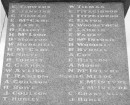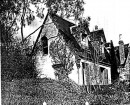ROTHBURY
389 YENDON-LAL LAL ROAD LAL LAL, MOORABOOL SHIRE
-
Add to tour
You must log in to do that.
-
Share
-
Shortlist place
You must log in to do that.
- Download report






Statement of Significance
What is significant?
Rothbury was probably built in the early 1860s and first occupied by JP Howard. It is a single storey, rendered brick house with a corrugated iron roof and return verandah with simple and elegant cast iron decoration. Three rooms along the front have french doors opening onto the verandah and the drawing room has an octagonal bay window.
The two main rooms, the drawing room and dining room, have painted decoration which was uncovered when wallpapers were removed in late 2001. The drawing room features the most extensive decoration with a Classical Revival decorative scheme painted on the ceiling and walls. The ceiling has female busts, horns and flowers painted in panels with elaborate borders. The walls have painted Corinthian pilasters with arches above and delicate floral swags between. The joinery and cornices have been painted white at a later stage, but there is evidence to suggest that they originally matched the early colour scheme. There are many plaster marks on the ceiling and walls. The unpainted shield shapes around the wall possibly mark the location of gas lamp brackets. There is evidence of further decoration under later paintwork.
The decoration in the dining room is more restrained. It is mainly a single colour with a stencilled dado and another dado line. There is another unpainted shield shape over the fireplace. Underneath later paintwork, further decorative work can be detected.
How is it significant?
Rothbury has aesthetic and historical significance to the State of Victoria.
Why is it significant?
Rothbury has historical significance for the rarity, quality and relative intactness of its early decorative schemes. Although elaborate interior decorative schemes were popular in Victorian times, remarkably few have survived. The painted decoration at Rothbury is a rare surviving essentially intact example of 19th century domestic decoration. The Rothbury example is also rare as an entirely painted scheme which does not feature wallpapers and elaborate plaster and timber work. The walls of the drawing and dining rooms and other areas in the house have the potential to reveal further early paint schemes.
Rothbury is aesthetically important for its decorated interior which is particularly sophisticated for this rather modest residence. The design on the drawing room ceiling combined with the simple columns and arches on the walls has been created as a comprehensive artistic work. The simplicity and delicacy of its style and execution set it apart from some of the more opulent decorative schemes of the time.
-
-
ROTHBURY - History
The original crown grant was to John Patrick Howard who first appears in the rate books for Lal Lal in 1867 with property worth £25. By 1872 it had jumped to £50. The property passed on to Alicia Howard, probably his widow in 1889 (Buninyong Rate Books, from National Trust report). Well known Ballarat merchant Walter Bradby owned the property from 1896, later ownership was in the estate of Mr Bradby and Mr Ireland, bank manager. In 1938 a Mr Tippet owned the place (Ronaldson and Tippet, engines) until Mr Edwards, a shearer, bought it in 1942. It was sold to the present owner Richard Kelly in 1991. Some renovation had been undertaken by Edwards and it was possibly during his ownership that the decorated walls were covered with wallpaper. (research by Richard Kelly).
ROTHBURY - Permit Exemptions
General Exemptions:General exemptions apply to all places and objects included in the Victorian Heritage Register (VHR). General exemptions have been designed to allow everyday activities, maintenance and changes to your property, which don’t harm its cultural heritage significance, to proceed without the need to obtain approvals under the Heritage Act 2017.Places of worship: In some circumstances, you can alter a place of worship to accommodate religious practices without a permit, but you must notify the Executive Director of Heritage Victoria before you start the works or activities at least 20 business days before the works or activities are to commence.Subdivision/consolidation: Permit exemptions exist for some subdivisions and consolidations. If the subdivision or consolidation is in accordance with a planning permit granted under Part 4 of the Planning and Environment Act 1987 and the application for the planning permit was referred to the Executive Director of Heritage Victoria as a determining referral authority, a permit is not required.Specific exemptions may also apply to your registered place or object. If applicable, these are listed below. Specific exemptions are tailored to the conservation and management needs of an individual registered place or object and set out works and activities that are exempt from the requirements of a permit. Specific exemptions prevail if they conflict with general exemptions. Find out more about heritage permit exemptions here.Specific Exemptions:General Conditions: 1. All exempted alterations are to be planned and carried out in a manner which prevents damage to the fabric of the registered place or object. General Conditions: 2. Should it become apparent during further inspection or the carrying out of works that original or previously hidden or inaccessible details of the place or object are revealed which relate to the significance of the place or object, then the exemption covering such works shall cease and the Executive Director shall be notified as soon as possible. Note: All archaeological places have the potential to contain significant sub-surface artefacts and other remains. In most cases it will be necessary to obtain approval from Heritage Victoria before the undertaking any works that have a significant sub-surface component. General Conditions: 3. If there is a conservation policy and plan approved by the Executive Director, all works shall be in accordance with it. Note: The existence of a Conservation Management Plan or a Heritage Action Plan endorsed by Heritage Victoria provides guidance for the management of the heritage values associated with the site. It may not be necessary to obtain a heritage permit for certain works specified in the management plan. General Conditions: 4. Nothing in this declaration prevents the Executive Director from amending or rescinding all or any of the permit exemptions. General Conditions: 5. Nothing in this declaration exempts owners or their agents from the responsibility to seek relevant planning or building permits from the responsible authorities where applicable. Minor Works : Note: Any Minor Works that in the opinion of the Executive Director will not adversely affect the heritage significance of the place may be exempt from the permit requirements of the Heritage Act. A person proposing to undertake minor works may submit a proposal to the Executive Director. If the Executive Director is satisfied that the proposed works will not adversely affect the heritage values of the site, the applicant may be exempted from the requirement to obtain a heritage permit. If an applicant is uncertain whether a heritage permit is required, it is recommended that the permits co-ordinator be contacted.Exterior
* Construction of sheds, fencing and gates provided that the works do not adversely affect the fabric or appearance of the registered building.
* Demolition, removal and alteration of, and minor additions to (but not replacement of) all buildings not specified in the extent of registration.
* Minor repairs and maintenance which replace like with like.* Repainting of exterior elements in appropriate heritage colours.
* Removal of extraneous items such as air conditioners, pipe work, ducting, wiring, antennae, aerials etc, and making good.
* Installation or repair of damp-proofing by either injection method or grouted pocket method.
* Regular garden maintenance.
* Installation, removal or replacement of garden watering systems.
Interior
* Any interior works to buildings not specified in the registration.* Painting of walls and ceilings in all areas except the two rooms containing the early decorative schemes, provided the preparation work does not remove evidence of the original paint or other decorative schemes. Evidence of earlier schemes should be reported to Heritage Victoria.
* Removal of paint from originally unpainted or oiled joinery, doors, architraves, skirtings and decorative strapping.
* Installation, removal or replacement of carpets and/or flexible floor coverings.
* Installation, removal or replacement of curtain track, rods, blinds and other window dressings.
* Installation, removal or replacement of hooks, nails and other devices for the hanging of mirrors, paintings and other wall mounted artworks.
* Refurbishment of bathrooms and toilets including removal, installation or replacement of sanitary fixtures and associated piping, mirrors, wall and floor coverings.
* Installation, removal or replacement of kitchen benches and fixtures including sinks, stoves, ovens, refrigerators, dishwashers etc and associated plumbing and wiring.
* Installation, removal or replacement of ducted, hydronic or concealed radiant type heating provided that the installation does not damage existing skirtings and architraves and provided that the location of the heating unit is concealed from view.
* Installation, removal or replacement of electrical wiring provided that all new wiring is fully concealed and any original light switches, pull cords, push buttons or power outlets are retained in-situ. Note: if wiring original to the place was carried in timber conduits then the conduits should remain in-situ.
* Installation, removal or replacement of bulk insulation in the roof space.
* Installation, removal or replacement of smoke detectors.
ROTHBURY - Permit Exemption Policy
The primary aesthetic and historical significance of Rothbury lies in the rarity, quality and relative intactness of the early decorative schemes in the drawing room and dining room. The purpose of the permit exemptions is to allow works that do not impact on the significance of the place to occur without the need for a permit. Alterations that impact on the significance of the interior are subject to permit applications.
Any restoration of the decorative schemes should be carried out after consultation with Heritage Victoria.
The kitchen and bathroom will require updating in the future and alterations to these areas that do not affect the building structure are permit exempt.
-
-
-
-
-
ROTHBURY
 Victorian Heritage Register H1697
Victorian Heritage Register H1697
-
'CARINYA' LADSONS STORE
 Victorian Heritage Register H0568
Victorian Heritage Register H0568 -
1 Alexander Street
 Yarra City
Yarra City -
1 Botherambo Street
 Yarra City
Yarra City
-
-










